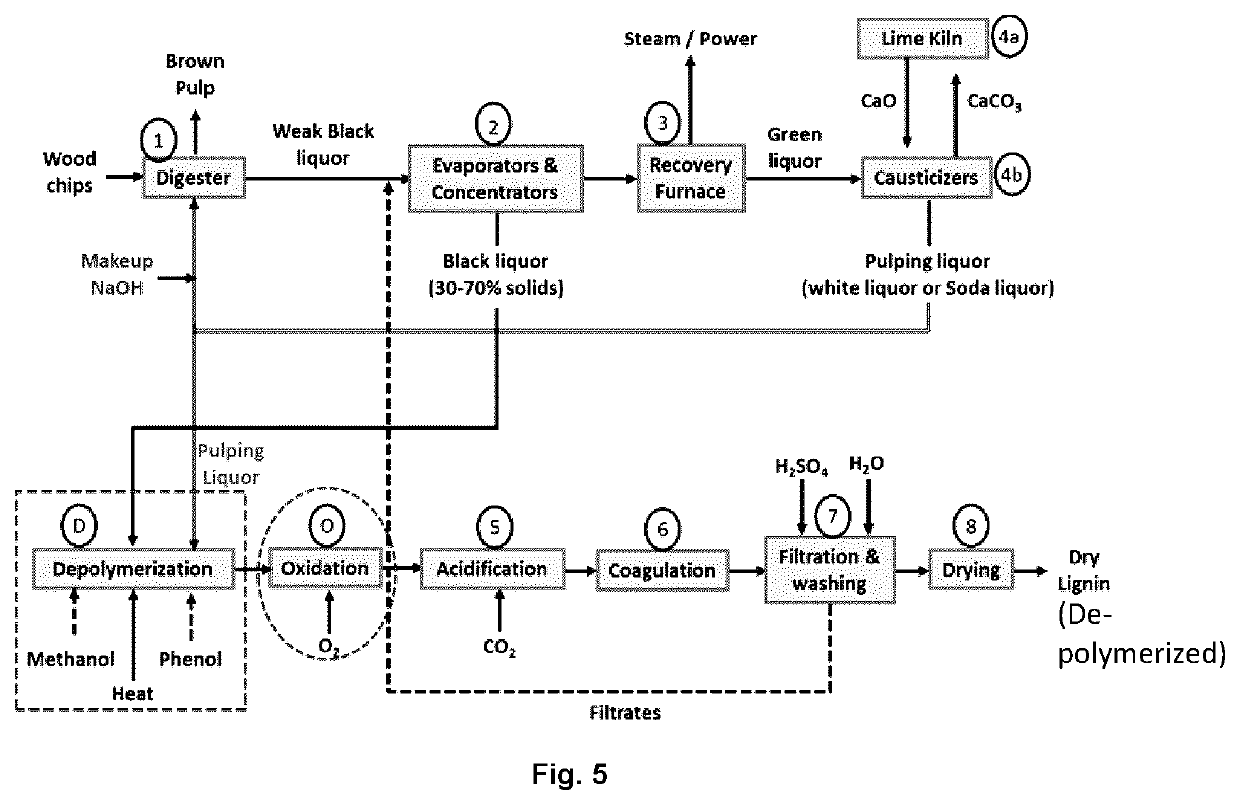Lignin depolymerization process using chemicals recoverable by the kraft recovery cycle
- Summary
- Abstract
- Description
- Claims
- Application Information
AI Technical Summary
Benefits of technology
Problems solved by technology
Method used
Image
Examples
example 1
Reaction of Lignin in Black Liquor in the Presence of Added Sodium Hydroxide
[0076]Using black liquor (BL) as the reaction substrate, a set of experiments was conducted under pre-selected conditions at temperatures ranging from 200-350° C. and reaction times ranging from 0.5-3 hours. The experiments were carried out in a 100-mL Parr reactor (Model 4848). A typical run employed 50 g BL (27.9 wt % solids content), under N2 at 2 MPa (initial pressure). The BL was initially charged into the reactor and the reactor was then sealed. The reactor was first vacuum-purged for 2-3 times with N2 in order to ensure the complete removal of any air or oxygen present inside the reactor. Subsequently, the reactor was pressurized with N2 to a pressure of 2 MPa and a leak test was conducted. The reactor was then heated up at a heating rate of about 5° C. / min under 300 rpm stirring. The reaction time was recorded from the point at which the target temperature was reached.
[0077]After completion of the re...
example 2
Depolymerization of Lignin in Black Liquor in the Presence of Added White Liquor
[0086]Using black liquor as the reaction substrate, a set of experiments were conducted in a batch 2 L Parr Model 4843 reactor, equipped with a pressure gauge, thermocouple, stirrer, gas lines (in and out) and sampling line. In a typical run, 500 mL of black liquor and 250 mL of white liquor (2:1(v / v)) were charged to the reactor. The reactor was then closed and tightened. The reactor was purged with N2 2-3 times to ensure the complete removal of any air or oxygen present inside the enclosed reactor. Subsequently, the reactor was pressurized with N2 to 2 bar (cold pressure), then a leak test was performed. The reactor was then heated up under stirring (670 rpm), and allowed to run over a pre-specified length of reaction time (1 hour) after the reactor reached the required temperature. Once the pre-determined reaction time was reached, the reactor was immediately quenched with cold water to stop further r...
example 3
Depolymerization of Hydrolysis Lignin in the Presence of Added NaOH or White Liquor
[0089]The depolymerization of hydrolysis lignin (HL) was carried out in a batch 2-L Parr Model 4843 reactor, equipped with a pressure gauge, thermocouple, stirrer, gas lines (in and out) and a sampling line. The HL used in this study was produced at FPlnnovations using its proprietary TMP-Bio process and washed with water before use. Two sets of experiments were carried out on the washed HL:[0090]a) 1-A: in this experiment, the following chemicals were charged to the reactor: 140 g HL, 250 mL white liquor and 500 mL deionized water;[0091]b) 2-A: in this experiment, the following chemicals were charged to the reactor: 250 g HL, 1300 mL deionized water and (60 mL NaOH or 120 mL NaOH).
[0092]The reactor was then closed and tightened. The reactor was purged 2-3 times with N2 to ensure the complete removal of any air or oxygen present inside the enclosed reactor. Subsequently, the reactor was pressurized wi...
PUM
| Property | Measurement | Unit |
|---|---|---|
| Temperature | aaaaa | aaaaa |
| Temperature | aaaaa | aaaaa |
| Mass | aaaaa | aaaaa |
Abstract
Description
Claims
Application Information
 Login to View More
Login to View More - R&D
- Intellectual Property
- Life Sciences
- Materials
- Tech Scout
- Unparalleled Data Quality
- Higher Quality Content
- 60% Fewer Hallucinations
Browse by: Latest US Patents, China's latest patents, Technical Efficacy Thesaurus, Application Domain, Technology Topic, Popular Technical Reports.
© 2025 PatSnap. All rights reserved.Legal|Privacy policy|Modern Slavery Act Transparency Statement|Sitemap|About US| Contact US: help@patsnap.com



